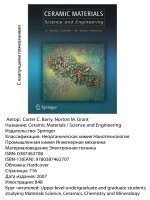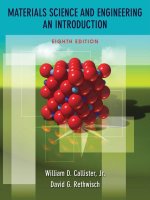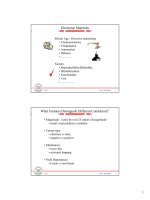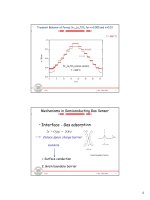Materials science and engineering an introduction complete solutions to selected problems callister 6th ed
Bạn đang xem bản rút gọn của tài liệu. Xem và tải ngay bản đầy đủ của tài liệu tại đây (6.36 MB, 556 trang )
Complete Solutions to Selected Problems
to accompany
MATERIALS SCIENCE
AND ENGINEERING
AN INTRODUCTION
Sixth Edition
William D. Callister, Jr.
The University of Utah
John Wiley & Sons, Inc.
Copyright 2003 John Wiley & Sons, Inc. All rights reserved.
No part of this publication may be reproduced, stored in a retrieval system or transmitted in any form or by
any means, electronic, mechanical, photocopying, recording, scanning or otherwise, except as permitted
under Sections 107 or 108 of the 1976 United States Copyright Act, without either the prior written
permission of the Publisher, or authorization through payment of the appropriate per-copy fee to the
Copyright Clearance Center, 222 Rosewood Drive, Danvers, MA 01923, (508)750-8400, fax (508)7504470. Requests to the Publisher for permission should be addressed to the Permissions Department, John
Wiley & Sons, Inc., 605 Third Avenue, New York, NY 10158-0012, (212) 850-6011, fax (212) 850-6008,
E-Mail:
To order books or for customer service please call 1(800)225-5945.
SOLUTIONS TO PROBLEMS
PREFACE
This section of instructor's resource materials contains solutions and answers to
all problems and questions that appear in the textbook. My penmanship leaves
something to be desired; therefore, I generated these solutions/answers using
computer software so that the resulting product would be "readable." Furthermore, I
endeavored to provide complete and detailed solutions in order that: (1) the instructor,
without having to take time to solve a problem, will understand what principles/skills are
to be learned by its solution; and (2) to facilitate student understanding/learning when
the solution is posted.
I would recommend that the course instructor consult these solutions/answers
before assigning problems and questions. In doing so, he or she ensures that the
students will be drilled in the intended principles and concepts. In addition, the
instructor may provide appropriate hints for some of the more difficult problems.
With regard to symbols, in the text material I elected to boldface those symbols
that are italicized in the textbook. Furthermore, I also endeavored to be consistent
relative to symbol style. However, in several instances, symbols that appear in the
textbook were not available, and it was necessary to make appropriate substitutions.
These include the following: the letter a (unit cell edge length, crack length) is used in
place of the cursive a. And Roman E and F replace script E (electric field in Chapter
18) and script F (Faraday's constant in Chapter 17), respectively.
I have exercised extreme care in designing these problems/questions, and then
in solving them. However, no matter how careful one is with the preparation of a work
such as this, errors will always remain in the final product. Therefore, corrections,
suggestions, and comments from instructors who use the textbook (as well as their
teaching assistants) pertaining to homework problems/solutions are welcomed. These
may be sent to me in care of the publisher.
1
CHAPTER 2
ATOMIC STRUCTURE AND INTERATOMIC BONDING
PROBLEM SOLUTIONS
2.1 (a) When two or more atoms of an element have different atomic masses, each is termed an
isotope.
(b) The atomic weights of the elements ordinarily are not integers because: (1) the atomic masses
of the atoms generally are not integers (except for
12
C), and (2) the atomic weight is taken as the
weighted average of the atomic masses of an atom's naturally occurring isotopes.
2.2 Atomic mass is the mass of an individual atom, whereas atomic weight is the average (weighted) of
the atomic masses of an atom's naturally occurring isotopes.
2.3 (a) In order to determine the number of grams in one amu of material, appropriate manipulation of
the amu/atom, g/mol, and atom/mol relationships is all that is necessary, as
⎛
⎞ ⎛ 1 g / mol ⎞
1 mol
# g/amu = ⎜
⎟
⎟⎜
23
atoms ⎠ ⎝ 1 amu / atom ⎠
⎝ 6.023 x 10
= 1.66 x 10-24 g/amu
(b) Since there are 453.6 g/lbm,
(
)(
23
1 lb - mol = 453.6 g/lbm 6.023 x 10
)
atoms/g - mol
= 2.73 x 1026 atoms/lb-mol
2.4 (a) Two important quantum-mechanical concepts associated with the Bohr model of the atom are
that electrons are particles moving in discrete orbitals, and electron energy is quantized into shells.
(b) Two important refinements resulting from the wave-mechanical atomic model are that electron
position is described in terms of a probability distribution, and electron energy is quantized into both
shells and subshells--each electron is characterized by four quantum numbers.
2.5 The n quantum number designates the electron shell.
2
The l quantum number designates the electron subshell.
The m quantum number designates the number of electron states in each electron subshell.
l
The m quantum number designates the spin moment on each electron.
s
2.6 For the L state, n = 2, and eight electron states are possible. Possible l values are 0 and 1, while
1
possible ml values are 0 and ±1. Therefore, for the s states, the quantum numbers are 200 ( ) and
2
1
1
1
1
1
2
2
2
2
200 (− ) . For the p states, the quantum numbers are 210 ( ) , 210 (− ) , 211 ( ) , 211 (− ) ,
2
1
1
2
2
21(-1 )( ) , and 21(-1 )(− ) .
For the M state, n = 3, and 18 states are possible. Possible l values are 0, 1, and 2;
1
possible ml values are 0, ±1, and ±2; and possible ms values are ± . Therefore, for the s states,
2
1
1
1
1
1
2
2
1
2
1
2
1
2
2
the quantum numbers are 300 ( ) , 300 (− ) , for the p states they are 310 ( ) , 310 (− ) , 311 ( ) ,
2
1
1
1
2
1
2
1
2
1
1
1
1
1
2
2
2
2
2
2
2
311 (− ) , 31(-1 )( ) , and 31(-1 )(− ) ;
for the d states they are 320 ( ) , 320 (− ) , 321 ( ) ,
2
321 (− ) , 32(-1 )( ) , 32(-1 )(− ) , 322 ( ) , 322 (− ) , 32(-2) ( ) , and 32(-2) (− ) .
2.7 The electron configurations of the ions are determined using Table 2.2.
2 2 6 2 6 6
- 1s 2s 2p 3s 3p 3d
3+
2 2 6 2 6 5
Fe - 1s 2s 2p 3s 3p 3d
+
2 2 6 2 6 10
Cu - 1s 2s 2p 3s 3p 3d
2+
2 2 6 2 6 10 2 6 10 2 6
Ba - 1s 2s 2p 3s 3p 3d 4s 4p 4d 5s 5p
2 2 6 2 6 10 2 6
Br - 1s 2s 2p 3s 3p 3d 4s 4p
22 2 6 2 6
S - 1s 2s 2p 3s 3p
Fe
2.8
2+
+
The Na ion is just a sodium atom that has lost one electron; therefore, it has an electron
configuration the same as neon (Figure 2.6).
The Cl ion is a chlorine atom that has acquired one extra electron; therefore, it has an
electron configuration the same as argon.
2.9 Each of the elements in Group IIA has two s electrons.
2 2 6 2 6 7 2
2.10 (a) The 1s 2s 2p 3s 3p 3d 4s electron configuration is that of a transition metal because of an
incomplete d subshell.
3
2 2 6 2 6
(b) The 1s 2s 2p 3s 3p electron configuration is that of an inert gas because of filled 3s and 3p
subshells.
2 2 5
(c) The 1s 2s 2p electron configuration is that of a halogen because it is one electron deficient
from having a filled L shell.
2 2 6 2
(d) The 1s 2s 2p 3s electron configuration is that of an alkaline earth metal because of two s
electrons.
2 2 6 2 6 2 2
(e) The 1s 2s 2p 3s 3p 3d 4s electron configuration is that of a transition metal because of an
incomplete d subshell.
2 2 6 2 6 1
(f) The 1s 2s 2p 3s 3p 4s electron configuration is that of an alkali metal because of a single s
electron.
2.11 (a) The 4f subshell is being filled for the rare earth series of elements.
(b) The 5f subshell is being filled for the actinide series of elements.
2.12 The attractive force between two ions FA is just the derivative with respect to the interatomic
separation of the attractive energy expression, Equation (2.8), which is just
FA =
dE A
dr
⎛ A⎞
d⎜− ⎟
⎝ r⎠
A
=
= 2
dr
r
The constant A in this expression is defined in footnote 3. Since the valences of the Ca2+ and O2ions (Z1 and Z2) are both 2, then
FA =
(Z1e )(Z2e)
4πεor 2
(
−19
(2)(2 ) 1.6 x 10
=
(
(4)(π) 8.85 x 10
−12
)
C
)(
2
F / m) 1.25 x 10
= 5.89 x 10-10 N
2.13 (a) Differentiation of Equation (2.11) yields
dEN
dr
=
A
−
r(1 + 1)
4
nB
r(n + 1)
= 0
−9
)
m
2
(b) Now, solving for r (= r )
o
A
ro 2
nB
=
ro(n + 1)
or
⎛ A⎞
ro = ⎜ ⎟
⎝ nB ⎠
1/(1 - n)
(c) Substitution for ro into Equation (2.11) and solving for E (= Eo)
Eo = −
= −
A
B
+
r
ron
o
A
⎛ A⎞
⎜ ⎟
⎝ nB ⎠
1/(1 - n)
+
B
⎛ A⎞
⎜ ⎟
⎝ nB ⎠
n/(1 - n)
2.14 (a) Curves of E , E , and E are shown on the plot below.
A R
N
5
(b) From this plot
r = 0.24 nm
o
E = -5.3 eV
o
(c) From Equation (2.11) for E
N
A = 1.436
-6
B = 7.32 x 10
n=8
Thus,
⎛ A⎞
ro = ⎜ ⎟
⎝ nB ⎠
⎡
1.436
⎢
= ⎢
-6
⎢⎣(8) 7.32 x 10
(
1/(1 - n)
1/(1 - 8)
⎤
⎥
⎥
⎥⎦
= 0.236 nm
)
and
Eo = −
1.436
⎡
⎤
1.436
⎢
⎥
⎢ (8) ⎛ 7.32 x 10−6 ⎞ ⎥
⎠⎦
⎣ ⎝
1/(1 − 8)
+
7.32 x 10 −6
⎡
⎤
1.436
⎢
⎥
⎢ (8) ⎛ 7.32 x 10 −6 ⎞ ⎥
⎠⎦
⎣ ⎝
8 /(1 − 8)
= - 5.32 eV
2.15 This problem gives us, for a hypothetical X+-Y- ion pair, values for ro (0.35 nm), Eo (-6.13 eV), and
n (10), and asks that we determine explicit expressions for attractive and repulsive energies of
Equations 2.8 and 2.9. In essence, it is necessary to compute the values of A and B in these
equations. Expressions for ro and Eo in terms of n, A, and B were determined in Problem 2.13,
which are as follows:
⎛ A⎞
ro = ⎜ ⎟
⎝ nB ⎠
6
1/(1 - n)
Eo = −
A
⎛ A⎞
⎜
⎟
⎝ nB ⎠
+
1/(1 - n)
B
⎛ A⎞
⎜
⎟
⎝ nB ⎠
n/(1 - n)
Thus, we have two simultaneous equations with two unknowns (viz. A and B). Upon substitution of
values for ro and Eo in terms of n, these equations take the forms
⎛ A ⎞ 1/(1 - 10)
0.35 nm = ⎜
⎟
⎝ 10B ⎠
− 6.13 eV = −
A
⎛ A ⎞
⎜
⎟
⎝ 10B ⎠
1/(1 − 10)
+
B
⎛ A ⎞
⎜
⎟
⎝ 10B ⎠
10 /(1 − 10)
Simultaneous solution of these two equations leads to A = 2.38 and B = 1.88 x 10-5.
Thus,
Equations (2.8) and (2.9) become
2.38
r
EA = −
ER =
1.88 x 10 −5
r10
Of course these expressions are valid for r and E in units of nanometers and electron volts,
respectively.
2.16 (a) Differentiating Equation (2.12) with respect to r yields
−r / ρ
dE
C
De
=
−
2
dr
ρ
r
At r = ro, dE/dr = 0, and
C
ro 2
=
De
− (ro /ρ)
ρ
Solving for C and substitution into Equation (2.12) yields an expression for Eo as
7
(2.12b)
Eo = De
ro ⎞
⎟
⎜1 −
ρ⎠
⎝
− (ro/ρ) ⎛
(b) Now solving for D from Equation (2.12b) above yields
D =
Cρe
(ro/ρ)
ro2
Substitution of this expression for D into Equation (2.12) yields an expression for Eo as
Eo =
⎞
C⎛ ρ
⎜⎜
− 1⎟⎟
r ⎝r
⎠
o o
2.17 (a) The main differences between the various forms of primary bonding are:
Ionic--there is electrostatic attraction between oppositely charged ions.
Covalent--there is electron sharing between two adjacent atoms such that each atom assumes a
stable electron configuration.
Metallic--the positively charged ion cores are shielded from one another, and also "glued" together
by the sea of valence electrons.
(b)
The Pauli exclusion principle states that each electron state can hold no more than two
electrons, which must have opposite spins.
2.18
Covalently bonded materials are less dense than metallic or ionically bonded ones because
covalent bonds are directional in nature whereas metallic and ionic are not;
when bonds are
directional, the atoms cannot pack together in as dense a manner, yielding a lower mass density.
2.19
The percent ionic character is a function of the electron negativities of the ions XA and XB
according to Equation (2.10). The electronegativities of the elements are found in Figure 2.7.
For MgO, XMg = 1.2 and XO = 3.5, and therefore,
2⎤
⎡
%IC = ⎢1 − e (− 0.25) (3.5 − 1.2) ⎥ x 100 = 73.4%
⎦
⎣
For GaP, XGa = 1.6 and XP = 2.1, and therefore,
8
2⎤
⎡
%IC = ⎢1 − e (− 0.25) (2.1−1.6) ⎥ x 100 = 6.1%
⎦
⎣
For CsF, XCs = 0.7 and XF = 4.0, and therefore,
2⎤
⎡
%IC = ⎢1 − e (− 0.25) (4.0 − 0.7) ⎥ x 100 = 93.4%
⎦
⎣
For CdS, XCd = 1.7 and XS = 2.5, and therefore,
2⎤
⎡
%IC = ⎢1 − e (− 0.25) (2.5 − 1.7 ) ⎥ x 100 = 14.8%
⎦
⎣
For FeO, XFe = 1.8 and XO = 3.5, and therefore,
2⎤
⎡
%IC = ⎢1 − e (− 0.25) (3.5 − 1.8) ⎥ x 100 = 51.4%
⎦
⎣
2.20 Below is plotted the bonding energy versus melting temperature for these four metals. From this
plot, the bonding energy for copper (melting temperature of 1084°C) should be approximately 3.6
eV. The experimental value is 3.5 eV.
9
2 2
2.21 For silicon, having the valence electron structure 3s 3p , N' = 4; thus, there are 8 - N' = 4 covalent
bonds per atom.
2 5
For bromine, having the valence electron structure 4s 4p , N' = 7; thus, there is 8 - N' = 1
covalent bond per atom.
2 3
For nitrogen, having the valence electron structure 2s 2p , N' = 5; thus, there are 8 - N' = 3
covalent bonds per atom.
2 4
For sulfur, having the valence electron structure 3s 3p , N' = 6; thus, there are 8 - N' = 2
covalent bonds per atom.
2.22 For brass, the bonding is metallic since it is a metal alloy.
For rubber, the bonding is covalent with some van der Waals. (Rubber is composed
primarily of carbon and hydrogen atoms.)
For BaS, the bonding is predominantly ionic (but with some covalent character) on the basis
of the relative positions of Ba and S in the periodic table.
For solid xenon, the bonding is van der Waals since xenon is an inert gas.
For bronze, the bonding is metallic since it is a metal alloy (composed of copper and tin).
For nylon, the bonding is covalent with perhaps some van der Waals. (Nylon is composed
primarily of carbon and hydrogen.)
For AlP the bonding is predominantly covalent (but with some ionic character) on the basis
of the relative positions of Al and P in the periodic table.
2.23 The intermolecular bonding for HF is hydrogen, whereas for HCl, the intermolecular bonding is van
der Waals. Since the hydrogen bond is stronger than van der Waals, HF will have a higher melting
temperature.
2.24 The geometry of the H O molecules, which are hydrogen bonded to one another, is more restricted
2
in the solid phase than for the liquid. This results in a more open molecular structure in the solid, and
a less dense solid phase.
10
CHAPTER 3
THE STRUCTURE OF CRYSTALLINE SOLIDS
PROBLEM SOLUTIONS
3.1 Atomic structure relates to the number of protons and neutrons in the nucleus of an atom, as well as
the number and probability distributions of the constituent electrons. On the other hand, crystal
structure pertains to the arrangement of atoms in the crystalline solid material.
3.2 A crystal structure is described by both the geometry of, and atomic arrangements within, the unit
cell, whereas a crystal system is described only in terms of the unit cell geometry. For example,
face-centered cubic and body-centered cubic are crystal structures that belong to the cubic crystal
system.
3.3 For this problem, we are asked to calculate the volume of a unit cell of aluminum. Aluminum has an
FCC crystal structure (Table 3.1). The FCC unit cell volume may be computed from Equation (3.4)
as
VC = 16R
3
(
-9
2 = (16) 0.143 x 10
)
m
3
2 = 6.62 x 10
3.4 This problem calls for a demonstration of the relationship a = 4R
unit cell shown below
Using the triangle NOP
11
-29
3
m
3 for BCC. Consider the BCC
(NP)2 = a 2 + a 2 = 2a 2
And then for triangle NPQ,
(NQ)2 = (QP )2 + (NP)2
But NQ = 4R, R being the atomic radius. Also, QP = a. Therefore,
(4R)2 = a 2 + 2a2 , or
a =
4R
3
3.5 We are asked to show that the ideal c/a ratio for HCP is 1.633. A sketch of one-third of an HCP unit
cell is shown below.
Consider the tetrahedron labeled as JKLM, which is reconstructed as
12
The atom at point M is midway between the top and bottom faces of the unit cell--that is MH = c/2.
And, since atoms at points J, K, and M, all touch one another,
JM = JK = 2R = a
where R is the atomic radius. Furthermore, from triangle JHM,
(JM) 2 = (JH)2 + (MH)2, or
a
2
2
= (JH )
⎛ c⎞
+ ⎜ ⎟
⎝ 2⎠
2
Now, we can determine the JH length by consideration of triangle JKL, which is an equilateral
triangle,
cos 30° =
a/ 2
=
JH
JH =
3
, and
2
a
3
Substituting this value for JH in the above expression yields
2
2
⎛ a ⎞
a2
c2
⎛ c⎞
⎜
⎟
a2 = ⎜
+
=
+
⎟
⎝ 2⎠
3
4
⎝ 3⎠
and, solving for c/a
13
c
=
a
8
= 1.633
3
3.6 We are asked to show that the atomic packing factor for BCC is 0.68. The atomic packing factor is
defined as the ratio of sphere volume to the total unit cell volume, or
APF =
VS
VC
Since there are two spheres associated with each unit cell for BCC
3
⎛ 4πR 3 ⎞
8πR
VS = 2(sphere volume) = 2 ⎜⎜
⎟⎟ =
3
⎝ 3 ⎠
3
Also, the unit cell has cubic symmetry, that is V = a . But a depends on R according to Equation
C
(3.3), and
⎛ 4R ⎞
VC = ⎜
⎟
⎝ 3⎠
3
=
64R 3
3 3
Thus,
APF =
8πR 3 / 3
64R 3 / 3 3
= 0.68
3.7 This problem calls for a demonstration that the APF for HCP is 0.74. Again, the APF is just the total
sphere-unit cell volume ratio. For HCP, there are the equivalent of six spheres per unit cell, and thus
⎛ 4π R3 ⎞
⎟⎟ = 8πR 3
VS = 6 ⎜⎜
3
⎝
⎠
Now, the unit cell volume is just the product of the base area times the cell height, c. This base area
is just three times the area of the parallelepiped ACDE shown below.
14
The area of ACDE is just the length of CD times the height BC . But CD is just a or 2R, and
BC = 2R cos (30°) =
2R 3
2
Thus, the base area is just
⎛ 2R 3 ⎞
2
AREA = (3)(CD )(BC) = (3)(2 R) ⎜
⎟ = 6R 3
2
⎝
⎠
and since c = 1.633a = 2R(1.633)
(
2
2
VC = (AREA)(c) = 6R c 3 = 6 R
)
3 (2)(1.633)R = 12 3 (1.633 )R
3
Thus,
APF =
VS
VC
3
=
8π R
12 3 (1.633 )R 3
= 0.74
3.8 This problem calls for a computation of the density of iron. According to Equation (3.5)
ρ =
nAFe
VC NA
For BCC, n = 2 atoms/unit cell, and
15
⎛ 4R ⎞
VC = ⎜
⎟
⎝ 3⎠
3
Thus,
ρ =
(2 atoms/unit cell)(55.9 g/mol)
3
⎫
⎧⎡
3
⎤
⎪
⎪
-7
23
⎨⎢(4 ) 0.124 x 10 cm / 3 ⎥ /(unit cell)⎬ 6.023 x 10 atoms/mol
⎪⎭
⎪⎩⎣
⎦
(
)
(
)
= 7.90 g/cm3
3
The value given inside the front cover is 7.87 g/cm .
3.9 We are asked to determine the radius of an iridium atom, given that Ir has an FCC crystal structure.
For FCC, n = 4 atoms/unit cell, and V = 16R
C
3
ρ =
2 [Equation (3.4)]. Now,
nAIr
V N
C A
And solving for R from the above two expressions yields
⎞
⎛ nA
Ir
⎟
R = ⎜⎜
⎟
⎝ 16ρN A 2 ⎠
⎡
⎢
= ⎢
⎢⎣
(
1/3
(4 atoms/unit cell)(192.2 g/mol)
2 )(16) 22.4 g/cm3 6.023 x 10 23 atoms/mol
(
)(
⎤
⎥
⎥
⎥⎦
1/3
)
= 1.36 x 10-8 cm = 0.136 nm
3.10 This problem asks for us to calculate the radius of a vanadium atom. For BCC, n = 2 atoms/unit cell,
and
⎛ 4R ⎞
VC = ⎜
⎟
⎝ 3⎠
16
3
=
64R 3
3 3
Since,
ρ =
nAV
V N
C A
and solving for R
⎛ 3 n 3A ⎞
V⎟
R = ⎜
⎜ 64ρN ⎟
A ⎠
⎝
1/3
⎡
3 3 (2 atoms/unit cell)(50.9 g/mol)
⎢
= ⎢
3
23 atoms/mol
⎢⎣ (64) 5.96 g/cm 6.023 x 10
( )
(
)(
⎤
⎥
⎥
⎥⎦
1/3
)
= 1.32 x 10-8 cm = 0.132 nm
3.11 For the simple cubic crystal structure, the value of n in Equation (3.5) is unity since there is only a
single atom associated with each unit cell. Furthermore, for the unit cell edge length, a = 2R.
Therefore, employment of Equation (3.5) yields
ρ =
nA
V N
=
C A
=
nA
(2R )3N
A
(1 atom/unit cell)(74.5 g/mol)
3
⎫⎪
⎪⎧⎡
23
-8
⎤
⎨⎢⎣(2) 1.45 x 10 cm ⎥⎦ /(unit cell)⎬ 6.023 x 10 atoms/mol
⎪⎭
⎪⎩
(
)
(
5.07 g/cm3
3.12. (a) The volume of the Ti unit cell may be computed using Equation (3.5) as
VC =
nATi
ρN
Now, for HCP, n = 6 atoms/unit cell, and for Ti, A
17
A
Ti
= 47.9 g/mol. Thus,
)
VC =
(6 atoms/unit cell)(47.9 g/mol)
23
3
4.51 g/cm 6.023 x 10 atoms/mol
(
)(
)
= 1.058 x 10-22 cm3/unit cell = 1.058 x 10-28 m3/unit cell
(b) From the solution to Problem 3.7, since a = 2R, then, for HCP
VC =
3 3 a 2c
2
but, since c = 1.58a
VC =
3 3 (1.58)a 3
-22
3
= 1.058 x 10
cm /unit cell
2
Now, solving for a
(
⎡ 2 1.058 x 10-22 cm3
⎢( )
a = ⎢
(3 ) 3 (1.58)
⎢⎣
( )
)⎤⎥
1/3
⎥
⎥⎦
= 2.96 x 10-8 cm = 0.296 nm
And finally
c = 1.58a = (1.58)(0.296 nm) = 0.468 nm
3.13 This problem asks that we calculate the theoretical densities of Al, Ni, Mg, and W.
(
Since Al has an FCC crystal structure, n = 4, and VC = 2R 2
)3 .
Also, R = 0.143 nm (1.43
x 10-8 cm) and AAl = 26.98 g/mol. Employment of Equation (3.5) yields
ρ =
(4 atoms/unit cell)(26.98 g/mol)
3
⎧
⎫
-8
23
atoms/mol
⎨ (2)(1.43 x 10 cm) 2 /(unit cell) ⎬ 6.023 x 10
⎩
⎭
[
( )]
(
= 2.71 g/cm3
The value given in the table inside the front cover is 2.71 g/cm3.
18
)
Nickel also has an FCC crystal structure and therefore
ρ =
(4 atoms/unit cell)(58.69 g/mol)
3
⎧
⎫
-8
23
atoms/mol
⎨ (2)(1.25 x 10 cm) 2 /(unit cell )⎬ 6.023 x 10
⎩
⎭
[
( )]
(
)
= 8.82 g/cm3
The value given in the table is 8.90 g/cm3.
Magnesium has an HCP crystal structure, and from Problem 3.7,
3 3 a 2c
2
VC =
and, since c = 1.624a and a = 2R = 2(1.60 x 10-8 cm) = 3.20 x 10-8 cm
(
)
3 3 (1.624) 3.20 x 10-8 cm
VC =
3
2
−22
= 1.38 x 10
3
cm /unit cell
Also, there are 6 atoms/unit cell for HCP. Therefore the theoretical density is
ρ =
nAMg
V N
C A
=
(6 atoms/unit cell)(24.31 g/mol)
-22
3
23
1.38 x 10
cm /unit cell 6.023 x 10 atoms/mol
(
)(
)
= 1.75 g/cm3
The value given in the table is 1.74 g/cm3.
Tungsten has a BCC crystal structure for which n = 2 and a =
and R = 0.137 nm. Therefore, employment of Equation (3.5) leads to
19
4R
; also AW = 183.85 g/mol
3
ρ =
(2 atoms/unit cell)(183.85 g/mol)
(
)
3
⎫
⎧⎡
-8
⎤
⎪⎪
⎪⎪⎢(4 ) 1.37 x 10 cm ⎥
23 atoms/mol
/(unit
cell)
⎬ 6.023 x 10
⎨⎢
⎥
3
⎪
⎪⎢
⎥⎦
⎪⎭
⎪⎩⎣
(
)
= 19.3 g/cm3
The value given in the table is 19.3 g/cm3.
3.14 In order to determine whether Nb has an FCC or BCC crystal structure, we need to compute its
density for each of the crystal structures. For FCC, n = 4, and a = 2 R 2 . Also, from Figure 2.6, its
atomic weight is 92.91 g/mol. Thus, for FCC
ρ =
nA
Nb
3
2R 2 N A
(
)
(4 atoms/unit cell)(92.91 g/mol)
3
⎧⎡
⎫
-8
23
2 ⎤ /(unitcell)⎬ 6.023 x 10 atoms / mol
⎨ (2) 1.43 x 10 cm
⎣
⎦
⎩
⎭
=
(
)( )
(
)
= 9.33 g/cm3
For BCC, n = 2, and a =
=
4R
, thus
3
(2 atoms/unit cell)(92.91 g/mol)
3
⎧
⎫
-8
⎡
⎪ (4) 1.43 x 10 cm ⎤
⎪
⎢
23
⎥
⎨
/(unitcell)⎬ 6.023 x 10 atoms/ mol
⎢
⎥
3
⎪⎢
⎪
⎥⎦
⎪⎩⎣
⎪⎭
(
)
(
)
= 8.57 g/cm3
which is the value provided in the problem. Therefore, Nb has a BCC crystal structure.
3.15 For each of these three alloys we need to, by trial and error, calculate the density using Equation
(3.5), and compare it to the value cited in the problem. For SC, BCC, and FCC crystal structures,
20
the respective values of n are 1, 2, and 4, whereas the expressions for a (since VC = a3) are 2R,
2 R 2 , and 4R / 3 .
For alloy A, let us calculate ρ assuming a BCC crystal structure.
ρ =
nAA
V N
C A
=
(2 atoms/unit cell)(43.1 g/mol)
3
⎫
⎧
-8
⎡
⎤
⎪⎪
⎪⎪⎢ (4) 1.22 x 10 cm ⎥
/(unit cell)⎬ 6.023 x 1023 atoms/mol
⎨⎢
⎥
3
⎪
⎪⎢
⎥⎦
⎪⎭
⎪⎩⎣
(
)
(
)
= 6.40 g/cm3
Therefore, its crystal structure is BCC.
For alloy B, let us calculate ρ assuming a simple cubic crystal structure.
ρ =
(1 atom/unit cell)(184.4 g/mol)
3
⎫⎪
⎪⎧⎡
⎤
-8
23
⎨⎢⎣(2 ) 1.46 x 10 cm ⎥⎦ /(unit cell)⎬ 6.023 x 10 atoms/mol
⎪⎩
⎪⎭
(
)
(
)
= 12.3 g/cm3
Therefore, its crystal structure is simple cubic.
For alloy C, let us calculate ρ assuming a BCC crystal structure.
ρ =
(2 atoms/unit cell)(91.6 g/mol)
3
⎫
⎧
-8
⎡
⎤
⎪⎪
⎪⎪⎢(4) 1.37 x 10 cm ⎥
/(unit cell)⎬ 6.023 x 1023 atoms/mol
⎨⎢
⎥
3
⎪
⎪⎢
⎥⎦
⎪⎭
⎪⎩⎣
(
)
(
= 9.60 g/cm3
Therefore, its crystal structure is BCC.
21
)
3.16 In order to determine the APF for U, we need to compute both the unit cell volume (VC) which is
just the product of the three unit cell parameters, as well as the total sphere volume (VS) which is
just the product of the volume of a single sphere and the number of spheres in the unit cell (n). The
value of n may be calculated from Equation (3.5) as
ρVC NA
n =
AU
(
)(
(19.05)(2.86)(5.87)(4.95) x10 -24 6.023 x 1023
=
283.03
= 4.01 atoms/unit cell
Therefore
⎞
⎛4
(4) ⎜ π R3 ⎟
⎠
⎝3
APF =
=
VC
(a)(b)(c)
VS
⎡4
3⎤
(4)⎢ (π)(0.1385) ⎥
⎣3
⎦
=
(0.286)(0.587)(0.495)
= 0.536
3.17 (a) From the definition of the APF
APF =
VS
VC
=
⎞
⎛4
n ⎜ πR 3 ⎟
⎠
⎝3
a 2c
we may solve for the number of atoms per unit cell, n, as
2
n =
(APF)a c
4
πR 3
3
22
)
(
(0.693)(4.59)2(4.95) 10 -24 cm3
=
(
)
4
π 1.625 x 10-8 cm
3
)
3
= 4.0 atoms/unit cell
(b) In order to compute the density, we just employ Equation (3.5) as
nAIn
ρ =
a2 c N
A
=
(4 atoms/unit cell)(114.82 g/mol)
2
⎤
⎡
23
-8
-8
atoms/mol
⎢ 4.59 x 10 cm 4.95 x 10 cm /unit cell ⎥ 6.023 x 10
⎦
⎣
(
)(
(
)
)
= 7.31 g/cm3
3. 18 (a) We are asked to calculate the unit cell volume for Be. From the solution to Problem 3.7
VC = 6R2c 3
But, c = 1.568a, and a = 2R, or c = 3.14R, and
3
VC = (6)(3.14) R
( )[0.1143 x 10-7 cm]
3
= (6) (3.14 ) 3
3
= 4.87 x 10−23 cm3 /unit cell
(b) The density of Be is determined as follows:
ρ =
For HCP, n = 6 atoms/unit cell, and for Be, A
ρ =
nA Be
VC NA
Be
= 9.01 g/mol. Thus,
(6 atoms/unit cell)(9.01 g/mol)
23
-23
3
4.87 x 10
cm /unit cell 6.023 x 10 atoms/mol
(
)(
23
)









